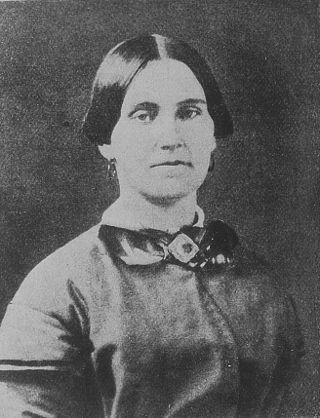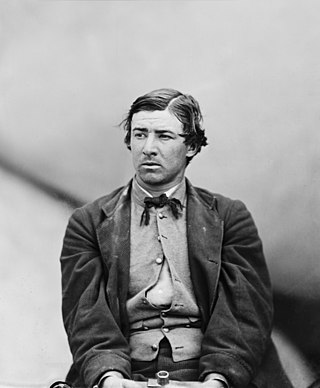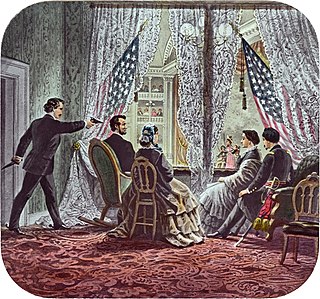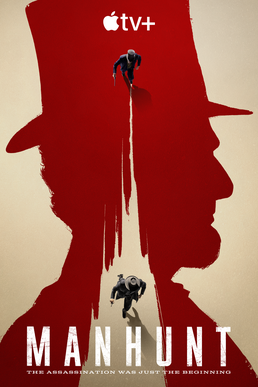
John Wilkes Booth was an American stage actor who assassinated United States President Abraham Lincoln at Ford's Theatre in Washington, D.C., on April 14, 1865. A member of the prominent 19th-century Booth theatrical family from Maryland, he was a noted actor who was also a Confederate sympathizer; denouncing President Lincoln, he lamented the then-recent abolition of slavery in the United States.

Samuel Alexander Mudd Sr. was an American physician who was imprisoned for conspiring with John Wilkes Booth concerning the assassination of Abraham Lincoln.

Mary Elizabeth Surratt was an American boarding house owner in Washington, D.C., who was convicted of taking part in the conspiracy which led to the assassination of U.S. President Abraham Lincoln in 1865. Sentenced to death, she was hanged and became the first woman executed by the U.S. federal government. She maintained her innocence until her death, and the case against her was and remains controversial. Surratt was the mother of John Surratt, who was later tried in the conspiracy, but was not convicted.

David Edgar Herold was an American pharmacist's assistant and accomplice of John Wilkes Booth in the assassination of Abraham Lincoln on April 14, 1865. After the shooting, Herold accompanied Booth to the home of Samuel Mudd, who set Booth's injured leg. The two men then continued their escape through Maryland and into Virginia, and Herold remained with Booth until the authorities cornered them in a barn. Herold surrendered, but Booth was shot to death by Sergeant Boston Corbett. Herold was tried by a military tribunal, sentenced to death for conspiracy, and hanged with three other conspirators at the Washington Arsenal, now known as Fort Lesley J. McNair.

George Andrew Atzerodt was a German American repairman, Confederate sympathizer, and conspirator in the assassination of U.S. President Abraham Lincoln. He was assigned to assassinate Vice President Andrew Johnson, but lost his nerve and made no attempt. Atzerodt was tried by a military tribunal, sentenced to death for conspiracy, and hanged along with three other conspirators.

Joseph Holt was an American lawyer, soldier, and politician. As a leading member of the Buchanan administration, he succeeded in convincing Buchanan to oppose the secession of the South. He returned to Kentucky and successfully battled the secessionist element thereby helping to keep Kentucky in the Union. President Abraham Lincoln appointed him the Judge Advocate General of the United States Army. He served as Lincoln's chief arbiter and enforcer of military law, and supporter of emancipation. His most famous roles came in the Lincoln assassination trials.

Lewis Thornton Powell was an American Confederate soldier who attempted to assassinate William Henry Seward as part of the Lincoln assassination plot. Wounded at the Battle of Gettysburg, he later served in Mosby's Rangers before working with the Confederate Secret Service in Maryland. John Wilkes Booth recruited him into a plot to kidnap Lincoln and turn the president over to the Confederacy, but then decided to assassinate Lincoln, Seward, and Vice President Andrew Johnson instead, and assigned Powell the task to kill Seward.

Louis J. Weichmann was an American clerk who was one of the chief witnesses for the prosecution in the trial following the assassination of Abraham Lincoln. Previously, he had also been a suspect in the conspiracy because of his association with Mary Surratt's family.

John Harrison Surratt Jr. was an American Confederate spy who was accused of plotting with John Wilkes Booth to kidnap U.S. President Abraham Lincoln; he was also suspected of involvement in the Abraham Lincoln assassination. His mother, Mary Surratt, was convicted of conspiracy by a military tribunal and hanged; she owned the boarding house that the conspirators used as a safe house and to plot the scheme.

On April 14, 1865, Abraham Lincoln, the 16th president of the United States, was shot by John Wilkes Booth while attending the play Our American Cousin at Ford's Theatre in Washington, D.C. Shot in the head as he watched the play, Lincoln died of his wounds the following day at 7:22 am in the Petersen House opposite the theater. He was the first U.S. president to be assassinated. His funeral and burial were marked by an extended period of national mourning.

Michael O'Laughlen, Jr. was an American Confederate soldier and conspirator in John Wilkes Booth's plot to kidnap U.S. President Abraham Lincoln, and later in the latter's assassination, although he ended up not directly participating.

Samuel Bland Arnold was an American Confederate sympathizer involved in a plot to kidnap U.S. President Abraham Lincoln in 1865. He had joined the Confederate Army shortly after the start of the Civil War but was discharged for health reasons in 1864.
John Minchin Lloyd was a bricklayer and police officer in Washington, D.C., in the United States. He was one of the first police officers hired by the Metropolitan Police Department of the District of Columbia when its Day Watch was first formed in 1855. He played a role in the trial of the conspirators in the Abraham Lincoln assassination. Arrested but never charged in the conspiracy, Lloyd's testimony was critical in convicting Mary Surratt.

The Prisoner of Shark Island is a 1936 American drama film that presents a highly whitewashed and fictionalized life of Maryland physician Samuel Mudd, who treated the injured presidential assassin John Wilkes Booth and later spent time in prison after his unanimous conviction for being one of Booth's accomplices. The film was produced by Darryl F. Zanuck, was directed by John Ford and starred Warner Baxter and Gloria Stuart.
James W. Pumphrey was a livery stable owner in Washington, D.C., who played a minor role in the events surrounding the assassination of Abraham Lincoln and its aftermath. Assassin John Wilkes Booth hired a horse from Pumphrey which he used to escape after the deed.

Frances Adeline Seward was the daughter of United States Secretary of State William H. Seward and his wife Frances Adeline Miller Seward. The youngest of five children born to the Sewards, she was their only daughter to survive to adulthood, although she herself died at the young age of 21.

The Conspirator is a 2010 American mystery historical drama film directed by Robert Redford and based on an original screenplay by James D. Solomon. It is the debut film of the American Film Company. The film tells the story of Mary Surratt, the only female conspirator charged in the Abraham Lincoln assassination and the first woman to be executed by the US federal government. It stars Robin Wright as Mary Surratt, together with James McAvoy, Justin Long, Evan Rachel Wood, Jonathan Groff, Tom Wilkinson, Alexis Bledel, Kevin Kline, John Cullum, Toby Kebbell, and James Badge Dale.

The Mary E. Surratt Boarding House in Washington, D.C. was the site of meetings of conspirators to kidnap and subsequently to assassinate U.S. President Abraham Lincoln. It was operated as a boarding house by Mary Surratt from September 1864 to April 1865.

Events from the year 1865 in the United States. The American Civil War ends with the surrender of the Confederate States, beginning the Reconstruction era of U.S. history.

Manhunt is an American historical drama miniseries created by showrunner Monica Beletsky, adapted from James L. Swanson's book Manhunt: The 12-Day Chase for Lincoln's Killer. The series follows Edwin Stanton's search for John Wilkes Booth in the aftermath of Abraham Lincoln's assassination. Directed by Carl Franklin and starring Tobias Menzies, the series was produced for Apple TV+, and released on March 15, 2024.


















